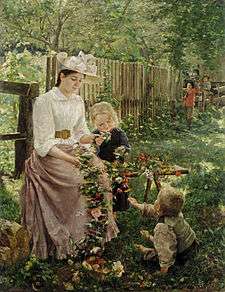Ivana Kobilca
| Ivana Kobilca | |
|---|---|
|
Self-portrait in White, around 1910 | |
| Born |
Ivana Kobilca December 20, 1861 Ljubljana, Carniola, Austrian Empire |
| Died |
December 4, 1926 (aged 64) Ljubljana, Kingdom of Serbs, Croats and Slovenes |
| Nationality | Slovene |
| Education |
School of Arts and Crafts, Munich study with the portrait painter Alois Erdtelt |
| Known for | Painting, drawing, photography |
| Notable work |
Dutch Girl (1886) Zitherist (around 1887) Coffeemadam (1888) Portrait of Sister Fani (1889) Summer (1889-90) Women Ironers (1891) Children in Grass (1892) Parisian Woman Selling Vegetables (1892) Self-Portrait (1894-95) Self-Portrait with a Palette (1914) |
| Movement | Realism |
| Elected | Société Nationale des Beaux-Arts |
Ivana Kobilca (20 December 1861 – 4 December 1926) is the most prominent Slovene female painter[1] and a key figure of Slovene cultural identity.[2] She was a realist painter who studied and worked in Vienna, Munich, Paris, Sarajevo, Berlin, and Ljubljana.[1] She mostly painted oil paintings and pastels, whereas her drawings are few.[3] The themes include still life, portraits, genre works, allegories, and religious scenes.[4] She was a controversial person, criticised for following movements that had not developed further in later periods.[2]
Biography

Ivana Kobilca was born in Ljubljana as a daughter in a wealthy family of a crafstman. Her parents gave great emphasis on education. At first, she learned how to draw, but also French and Italian, in the Ursuline High School in her home town, where her teacher of drawing was Ida Künl. When she was 16, she went with her father to Vienna, where she saw the paintings of old masters that inspired her. From 1879 to 1880, she studied in Vienna, where she copied the paintings at the gallery of the Academy of Arts, and from 1880 to 1881 in Munich. From 1882 to 1889, she continued her studies under Alois Erdtelt.[5] In 1888, she participated for the first time in a public exhibition.[5] At the following exhibition in Munich, her work was spotted and praised by the prominent German art historian Richard Muther.[5] and then returned to Ljubljana. In 1890, she painted in Zagreb. In 1891 and 1892, she painted in Paris in the private school of Henri Gervex. She became an honorary member (membre associée) of Société Nationale des Beaux Arts.[1] In 1892, she also painted in Barbizon. In 1893, she returned to Ljubljana, visited Florence in 1894, and lived in Sarajevo from 1897 to 1905. From 1906 to 1914, she lived in Berlin, and then returned to Ljubljana. At the time of her death in 1926 in Ljubljana, she was described as the greatest Yugoslav female painter.[2]
Works and meanings

Judging by her social origin, way of living, ideals and work, she was an urban artist. She is one of Slovene realists, who created their most important paintings in the 1880s. Kobilca's greatest tribute to Slovenian art was made during the time she lived abroad. Her greatest impact was on figural painting, especially portraits and paintings of typical people's lives in rustic or urban places. Since the time she had spent in Berlin, her most important genre became floral still life. Her early work reflects characteristics of München studio-work. The main colors are dark and brownish, only the pastels are light and rosy. From 1889 onwards her painting became lighter with blue nuances, typical for Parisian art at the time.
From here on, many artists took the next step that led into Impressionism, but Ivana Kobilca did not. In the latest period of her work, her ability to create fresh and interesting paintings started to fade. With some exceptions, her works of that period are dull and impersonal.
Kobilca's best known paintings are Kofetarica (Coffee Drinker), 1888; Citrarica (Zitherist), Likarice (Women Ironers), 1891; Holandsko dekle (Dutch Girl), Portret sestre Fani (Portrait of Sister Fani), 1889; and Poletje (Summer), 1889. Her work is on display at all major European galleries.[6]
.jpg)
Commemoration

After Slovenia declared independence from Yugoslavia, Kobilca was portrayed by Rudi Španzel on the 5000 Slovenian tolar banknote.[7] It was in circulation from December 1993 until the introduction of euro in January 2007.[7][8]
References
- 1 2 3 Šelih, Alenka; Antić Gaber, Milica; Puhar, Alenka; Rener, Tanja; Šuklje, Rapa; Verginella, Marta (2007). "Ivana Kobilca (1861–1926): Najslavnejša slovenska slikarka" [Ivana Kobilca(1861–1926): The Most Famous Slovene Woman Painter]. Pozabljena polovica: portreti žensk 19. in 20. stoletja na Slovenskem [Forgotten Half: The Portraits of Women of the 19th and 20th Century in the Slovene Lands] (in Slovenian). Založba Tuma [Tuma Publishing House], Slovenian Academy of Sciences and Arts. pp. 75–78. ISBN 978-961-6682-01-5.
- 1 2 3 Tanja, Mastnak (2004). "Ivana Kobilca in možnosti likovnega izobraževanja za ženske v 19. stoletju" [Ivana Kobilca and the Possibilities of Visual Arts Education for Women in the 19th Century]. Časopis za kritiko znanosti (in Slovenian). Študentska založba. 32 (215/216).
- ↑ Mesesnel, France (2009). "Kobilca Ivana". In Vide Ogrin, Petra (electronic ed.). Cankar, Izidor et al. (printed ed.). Slovenski biografski leksikon (in Slovenian). ISBN 978-961-268-001-5.
- ↑ "Ivana Kobilca". Oxford Art Online. Oxford University Press. 2003.
- 1 2 3 Menaše, Ljerka; Menaše, Luc (1979). "Ivana Kobilca". Fine Arts and Slovenians. Ljubljana: National Gallery. Retrieved 18 March 2012.
- ↑ "Famous Slovenians". Permanent Mission of Slovenia to the United Nations. Retrieved 18 March 2012.
- 1 2 Šiška, Marko (January 2012). "Twenty Years of National Currency". Www.ukom.gov.si. Government Communication Office, Republic of Slovenia.
- ↑ "5000 SIT". Banka Slovenije [Bank of Slovenia]. 2006. Retrieved 25 January 2013.
External links
| Wikimedia Commons has media related to: |
- Ivana Kobilca at National Gallery in Ljubljana (in Slovene)
